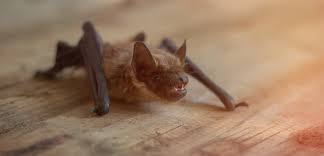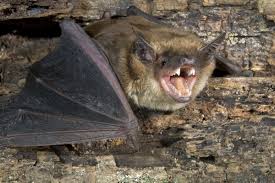IF A BAT GETS INSIDE MY HOME, HOW CAN I GET IT OUT?
A single bat flying in the house is rarely cause for alarm and can usually be dealt with easily. In most cases, the “lost” bat is trying frantically to locate an exit and will leave on its own, though leaving may be more challenging for the bat than getting in! The animal can be assisted by opening a window or exterior door. Doors to adjacent rooms should be closed, all lights should be turned on, and ceiling fans turnedoff. It is important to remain quiet and patient as the bat finds its way outside. If the bat does not leave on its own, and if no direct contact with people or pets that may have resulted in a bite has occurred, the bat can be safely captured and released outside.
Please Note: A bat that has bitten someone MUST be tested for rabies. If there is a chance that a person or pet was bitten, contain the bat and call your local Animal Control Agency. Then consult with your doctor or your state or local health department. A bite from any wild or unfamiliar mammal, including dogs and cats, should always be taken seriously. If the rabies status of the offending animal cannot be confirmed as negative, post-exposure rabies vaccinations will be required.
Follow these steps to capture a bat for release or for testing:
1. There is no need to chase a bat; simply wait quietly until the bat lands, then, wearing leather gloves, cover it with a small box or other container.
2. Gently, slip a piece of cardboard or a large envelope between the container and the surface where the bat has landed. Be careful that no part of the bat is caught between the box or can and the cardboard. Then slowly turn the box over, containing the bat inside.
* If the bat must remain in the box for several hours (e.g., it’s daytime and you want to wait until dark to release) place a soft cloth (non-terry) in the box before securing a cover. Most bats are very small, and can escape from a container with a loose-fitting lid, so be sure your cover is secure, but not air-tight. Smallholes can be made for ventilation.
3. Place the container in a quiet, safe place and wait until dark before releasing the bat outdoors (a bat released during the day is vulnerable to predators).
4. Most bats need to drop into flight from an elevated location, so don’t place the container on the ground. Place it on its side so the bat can easily climb out onto a tree limb or a second story deck, etc.
5. Watch until the bat flies away.

How long do bats live in a house?
No matter what creature you are talking about, every animal, at some point, dies. Nothing lives forever and that is true of the bat as well. While these creatures may seem like they will live forever because of how ugly they are, they eventually pass on as well which is hailed as good news by any person who has had a bat get into their home before.
This makes some wonder if a bat got into their home how long it could live there within the walls or the attic of their house? That’s a really good question, but one that is a little more misleading to answer and you may think.
How Long a Bat Lives
The average bat lives between 10 years and 20 years. The survival into adulthood depends greatly upon the amount of food that’s available to it and the type of shelter that is available as well. If a bat is well fed and is well protected within the shelter that it lives, it is quite likely that this animal will live to be near the 20 year range, especially considering that there are not many natural predators to these ugly looking creatures.
What this tells you is that a bat has a very good opportunity to live to be as much as 15 or 20 years old if it were to live in or directly around your home. If there are rodents or large insects for it to eat, and it has a safe place to live in, like in your attic, then it can stay there for years without issue. Because so few people spend any significant time in their attic the bat has virtual solitude and can stay there almost uninterrupted.
That is the good news.
Now the Bad News
This is why this question is so difficult to answer. If you are talking about just one bat then the worst case scenario for you is that the bat would be there for 15 years before it died. At that point it would be gone and you would have no issue.
However, the problem is that bats usually live in large colonies. In fact, these colonies can number into the hundreds or thousands of bats. Now, when you are considering how long they can live in your home, you are talking about the fact that hundreds of bats, reproducing and caring for each other, can live for generations in your home in less you do something to get rid of them. Is that bad news? You better believe it is.
A lot of times the reaction that people have to any kind of animal like this getting into their home is that they believe the animal will eventually just go away. That may be true in the case of some animals. Birds, for example, fly south for the winter giving you an opportunity to ensure that they can’t return by sealing a hole or crack in your siding where they are gaining entrance. A bat is a totally different story, however.

SIGNS THAT YOU HAVE A BAT PROBLEM
One obvious sign of a bat infestation is guano in the house. Bats leave droppings at the entrance to the roost area that can accumulate on walls, windowsills, or porches or on areas below the entrance to the roost. Guano looks like mouse droppings, but larger. Check your attic for droppings. You may also see stains from bat urine on the walls or ceiling.
Bats are nocturnal and leave the roost to feed at night. You may hear small squeaking noises or scratching sounds coming from the walls, attic, or chimney as they crawl to leave the roost at dusk and return at dawn. Bats tend to be quiet, so you might not hear them unless a loud noise, such as a slamming door, frightens them.
You may see rub marks on the outside of your house around an area with cracks or holes. Bats can leave these marks when they enter or exit the building.
If you notice any of these signs and want to get confirmation and an idea of how many bats are living in your house, you can look for them at night. Sit outside your house in a chair and wait to see the bats when they leave. This can also help you figure out where their entry point is.

Do Bats Avoid Lights?
Bats are very commonly misunderstood animals. They are mammals classified into the Chiroptera family. They look rat-like but possess webbed fore limbs. Bats are known to be the only mammals that can fly both long and short distance. And they are the only nocturnal mammals that fly. Why do these creatures avoid daylight, sleep in the day, and fly only at night?
Also commonly asked is the question of whether bats are blind or can see as clearly as other animals? This still brings to the front burner, the relationship between bats and light.
Bats are definitely not blind, but have accurate vision. They also avoid both natural and artificial lights. Being nocturnal animals, they are adapted to extreme low light conditions. When bats are in flight during the night, they are conscious of artificial lights and avoid them as much as they can. They also avoid pitching their roost in areas that may have a direct access to shining light.
Bat Prevention
Bats are beneficial to the environment and help control mosquito populations, but they sometimes get too close for comfort. When the pests roost on or inside homes, residents often look for fast, easy methods in commercially available repellents. Unfortunately, repelling bats is hard work that requires an eye for long-term control, which most common products do not provide.
Common Bat Repellents
Somewhere along the way, mothballs became associated with bat prevention. The smell of naphthalene, the active ingredient in mothballs, is disliked by the pests. However, using them to keep bats away is impractical. First, the smell dissipates quickly, which means homeowners will have to replace them regularly to repel bats. Next, the amount required to generate enough odour is so large, it will waft into human living spaces
There are products that promise to keep bats away electronically or ultrasonically, by emitting light or sound. These can be expensive and are generally ineffective over time. There are also aerosol sprays marketed for use against cats and dogs that are repurposed to repel bats. However, they are typically inadequate, as well.